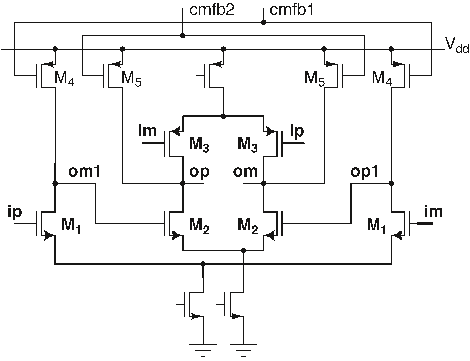




Did you find this useful? Give us your feedback


![Fig. 4. Feedforward-compensated opamp in [5].](/figures/fig-4-feedforward-compensated-opamp-in-5-20vn9jhu.png)













67 citations
62 citations
35 citations
15 citations
111 citations
...IN zero-intermediate-frequency integrated-circuit radio receivers, low-pass filters [1]–[3] are used before analog/ digital conversion....
[...]
97 citations
65 citations
...2(a), the feedforward stage gmf provides a high-speed path from the input to the output for frequency compensation [5]....
[...]
...For a given unity gain frequency and bias current, higher gain at low frequencies can be obtained using feedforward-compensated opamps [5] instead of their Miller-compensated counterparts....
[...]
...4 shows the feedforward-compensated opamp proposed in [5]....
[...]
46 citations
...In a first-order passive RC filter, the ratio of the power dissipated Pd to the product of the bandwidth fB and the SNR is a fundamental constant [13], i....
[...]
27 citations
...The tuning bits are updated based on the result of the comparison [7]....
[...]
The replica integrator is initially reset, and an internally generated reference voltage Vref (approximately 400 mV) is applied to it for a period of 100 ns.
With nominal resistor and capacitor values, the replica integrator’s time constant 1/ω0 is 100 ns when the digital bits are set to midcode.
Because multiple inputs are summed, the loop gain tends to be lower, and the distortion tends to be higher than in an amplifier with a single input.
By determining the transfer function of the filter path and the buffer pathfor both positive and negative settings of the buffer gain, the external feedthrough can be cancelled, and the transfer function of the filter can be accurately measured [9].
A 5-bit control word b〈4 : 0〉 switches the resistors and the capacitors and varies the RC product from 55% to 175% of the midcode value to compensate for process variations.
5. Separate common-mode feedback circuit (CMFB) stages are used to drive current sources M4 and M5 and to stabilize the common-mode output of each stage.
Its transconductance, which depends on Rgm and the transconductance of Ma, is adjusted to be equal to a3/R in the nominal process corner.
Power-efficient feedforward-compensated opamps in the integrators and feedforward current injection in the summing amplifier enable filters with an inherently high IIP3.
After five cycles of successive approximation, the bits converge to a value that sets the time constant of the replica integrator to 100 ns.
In the small number of characterized samples, the 3-dB bandwidth after automatic tuning is 16.3–16.6 MHz in the high-bandwidth mode and 7.5–8.4
In their implementation [see Fig. 7(c)], only a3x3/R, which is the largest component of the output current, is injected to the output using a transconductor.
Doubling the feedback capacitor array, as shown in Fig. 1(b), halves the bandwidth to 8.5 MHz while maintaining the same passbandnoise spectral density as required in WLAN receivers.